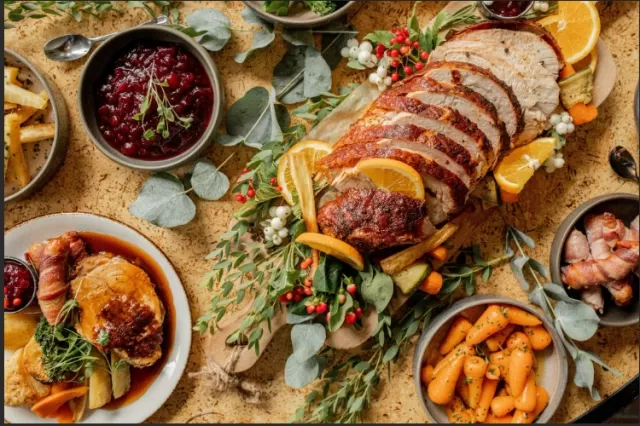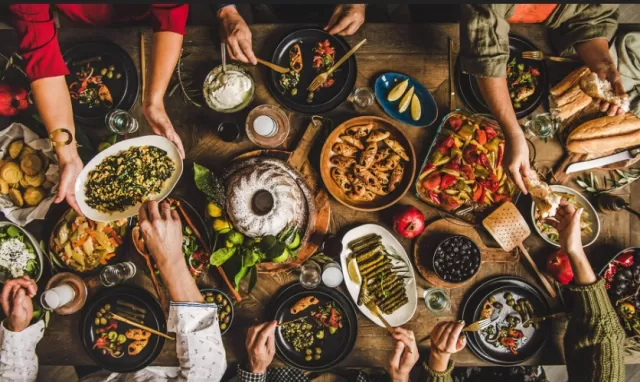Global New Year’s Eve Culinary Traditions. New Year’s Eve, with its magical blend of reflection on the past and the promise of a fresh start, is a universally cherished occasion. Across the globe, people welcome the new year with diverse and joyous celebrations, often woven together by the common thread of festive food. Let’s explore the ways several cultures mark this special moment, each culinary tradition carrying its own symbolism of good fortune.
Savoring Luck: The Spanish Tradition of Eating 12 Grapes on Nochevieja

In Spain, the art of celebration on New Year’s Eve, known as Nochevieja, takes a unique and flavorful turn when the clock strikes midnight.
Rather than a grand countdown or watching a ball drop, Spaniards partake in a delightful ritual—eating 12 grapes. Yes, precisely 12 grapes, each one consumed to coincide with the 12 strokes of midnight, broadcasted from a historic clock tower in Madrid.
This tradition, dating back to the 1880s, holds a special place in Spanish culture.
Those who manage to consume all 12 grapes by the final bell toll are believed to secure good luck for each of the upcoming 12 months. The act of savoring these grapes, while the clock tower chimes in the background, is a whimsical and charming way for Spaniards to welcome the new year.
Over the years, this unique custom has transcended borders and spread to various Spanish-speaking countries around the world.
The simplicity of eating 12 grapes has become a symbol of shared joy and optimism, connecting people in different corners of the globe through a shared tradition. So, as the clock strikes midnight in Spain, the ritual of eating 12 grapes becomes a universal gesture of hope and prosperity for the months that lie ahead.
Brazilian New Year\’s Eve: A Feast of Sevens and Spectacular Celebrations
In Brazil, the arrival of the new year is celebrated with a rich tapestry of traditions, each woven with symbolic significance.
Among the customs, the theme of lucky sevens takes center stage, creating a vibrant and meaningful tapestry of rituals.
As the clock strikes midnight, Brazilians engage in a unique practice of jumping in seven waves, all while making seven heartfelt wishes.
This dynamic ritual is believed to invite good fortune and positive energy for the upcoming year, as the rhythmic waves of the ocean serve as a backdrop to their aspirations.
The theme of sevens extends to the culinary realm as well.
Brazilians indulge in the consumption of seven grapes, a symbol of abundance, and seven pomegranate seeds, believed to usher in prosperity for the new year. Each bite is a flavorful affirmation of hope and plenty, embraced with the spirit of celebration.
For those seeking a non-food adventure, Rio de Janeiro offers the grandest spectacle in South America—a breathtaking fireworks show that illuminates the night sky in a dazzling array of colors.
To fully immerse in the festivities, locals and visitors alike don the color white, a symbol of purity and renewal.
In Brazil, New Year’s Eve becomes a sensory celebration, where traditions of sevens intertwine with the rhythm of waves, the taste of grapes, and the brilliance of fireworks, creating a magical atmosphere that heralds the arrival of a promising new year.
Turkish New Year\’s Eve: Pomegranates, Seeds, and Symbolic Scattering

In Turkey, the celebration of New Year’s Eve takes a vibrant and unique turn with a tradition involving the jewel-like seeds of pomegranates.
As the clock strikes midnight, don’t be surprised if you witness an intriguing sight—someone smashing a pomegranate on their doorstep. Far from an act of frustration, this symbolic gesture is a hopeful ritual, believed to bring good fortune for the upcoming year.
The scattering of pomegranate seeds is a visual metaphor for the spreading of prosperity and positive energy.
Some individuals opt for a simpler approach by cutting open a pomegranate at the stroke of midnight, letting the seeds fall freely. Others take it a step further, choosing to scatter salt over their doorstep with the same optimistic hope for good fortune.
In this Turkish tradition, pomegranates become a symbol of abundance, and the act of breaking them open signifies the release of positive energy and prosperity into the home.
The ritual encapsulates the essence of hope and renewal, creating a visually striking and culturally rich moment as the new year unfolds.
As the seeds glisten on doorsteps and salt is scattered in anticipation, Turkish New Year’s Eve becomes a celebration of symbolism and tradition, where the simple act of breaking open a pomegranate holds the promise of a bountiful and auspicious year ahead.
Japanese New Year\’s Eve: Toshikoshi Soba and Mochitsuki Traditions
In Japan, New Year’s Eve is a time for embracing traditions that blend culinary delights with symbolic significance.
If the idea of enjoying a steaming bowl of soba noodle soup paired with mochi excites your taste buds, then Japan is the place to be for this delightful celebration.
The focal point of this culinary tradition is toshikoshi soba, which translates to “year-crossing noodles” or “New Year’s Eve noodles.
” This practice, dating back to the 13th century, holds deep symbolism. Consuming a hot bowl of toshikoshi soba on New Year’s Eve is believed to facilitate bidding farewell to the old year and ushering in the new one with a sense of renewal.
Soba noodles, made from buckwheat, carry profound symbolism in Japanese culture.
Slurping the noodles is thought to bring about a fulfilling and prosperous life, and the buckwheat itself is associated with strength and resilience—a perfect metaphor for embracing the challenges of the upcoming year.
Additionally, another cherished Japanese New Year custom is mochitsuki, where individuals come together on New Year’s Eve to pound sweet, glutinous rice into mochi.
This communal activity is a reflection of unity and shared effort, as people engage in the rhythmic pounding to create the chewy and delectable mochi.
While indulging in these traditions, it’s important to exercise caution with mochi, as the chewy treats can pose a choking hazard.
Through the flavors of toshikoshi soba and the communal spirit of mochitsuki, Japanese New Year’s Eve becomes a celebration of culinary artistry and cultural richness, intertwining the joy of shared meals with the symbolism of welcoming a new and promising year.
Bulgarian New Year\’s Eve Feast: Banitsa and Fortunes Wrapped in Phyllo

In Bulgaria, New Year’s Eve is a time of abundant feasting, with tables laden with a variety of delectable dishes.
The festive holiday dinner often features hearty centerpieces such as pork with cabbage or roasted turkey. However, one culinary tradition that stands out during this celebration is the preparation of banitsa—a special kind of borek, a cheese-stuffed pastry that holds a place of honor on the Bulgarian table, reserved for Christmas and New Year’s Eve.
The artistry of crafting banitsa involves rolling egg and cheese in delicate phyllo dough, forming a tight circle that is then baked to golden perfection.
What makes the New Year’s banitsa particularly enchanting is the inclusion of extra special touches—charms, symbolic objects (like a small dogwood branch with a bud symbolizing health), coins, and handwritten wishes, all carefully wrapped in aluminum foil. These treasures are hidden within the layers of the banitsa, transforming the act of enjoying a piece into a magical experience akin to having one’s fortune told.
To add an element of fun, determining who gets which portion of the banitsa can involve spinning it on the table.
Each bite becomes a moment of anticipation, as individuals discover the hidden treasures within their slices, unveiling not only a delightful culinary treat but also a glimpse into their fortunes for the upcoming year.
As Bulgarians gather around their tables on New Year’s Eve, banitsa becomes a symbol of tradition, luck, and shared joy, creating a uniquely enchanting celebration that blends culinary artistry with the magic of hidden fortunes.
*The information is for reference only.